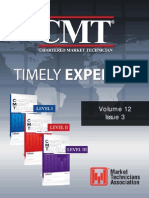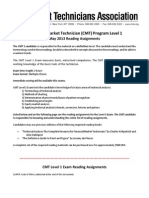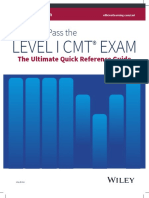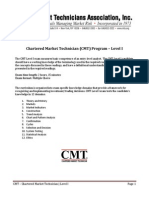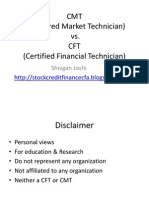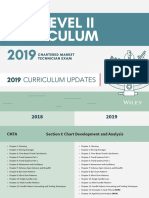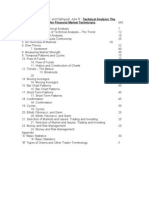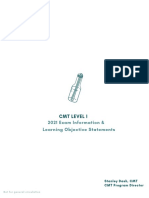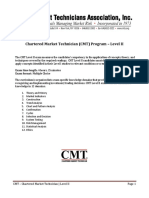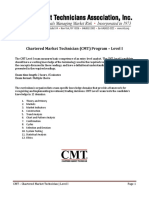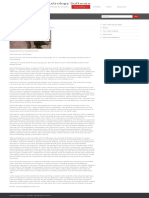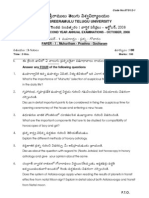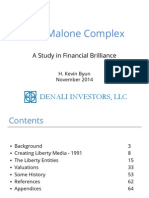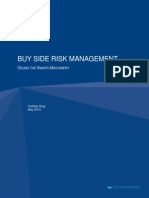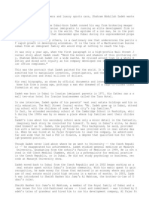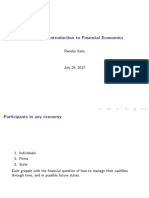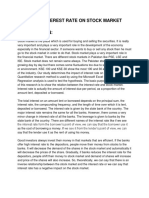Chartered Market Technician (CMT) Program Level II
The CMT Level II exam measures the candidates competency in the application of concepts, theory, and
techniques covered by the required readings. CMT Level II candidates must demonstrate their ability to
apply concepts identified in their Level I studies to relevant conditions or scenarios.
Exam time length: 4 hours, 15 minutes
Exam format: Multiple Choice
The curriculum is organized into exam specific knowledge domains that provide a framework for
recognizing and implementing investment/trading decisions. CMT Level II exam tests the candidates
knowledge in 12 domains:
1.
2.
3.
4.
5.
6.
7.
8.
9.
10.
11.
12.
Theory and History
Market Indicators
Construction
Trend Analysis
Chart and Pattern Analysis
Confirmation
Cycles
Selection and Decision
System Testing
Risk Management
Statistical Analysis
Ethics
CMT Chartered Market Technician | Level II
Page 1
�CMT Level II Exam Topics & Question Weightings
1. Theory and History
a. behavioral finance
b. Andrew Los Adaptive Market
Hypothesis
a. breadth indicators (e.g., A/D,
up/down volume)
b. index construction
c. sentiment measures (e.g., put-call
ratio, investor polls)
d. volatility (e.g., vix, historical, implied)
5%
8%
13
3. Construction
a. volume
3%
4. Trend Analysis
a. trendlines
b. multiple time frame analysis
15%
23
15%
23
6%
3%
10%
15
10%
15
15%
22
2. Market Indicators
c.
5. Chart and Pattern
Analysis
breakouts (from channels or chart
patterns)
d. moving averages
e. trend strength indicators (e.g., DMI,
ADX, etc.)
a. gap analysis
b. support and resistance
6. Confirmation
7. Cycles
8. Selection and Decision
9. System Testing
10. Risk Management
a. oscillators and divergence
b. sector rotation
c. intermarket signals
1.seasonal cycles
a. noncorrelated assets
b. relative strength
c. forecasting techniques (pattern and
trend recognition)
a. algorithmic development
b. optimizing entry and exit rules
(filtering)
c. equity curve analysis
d. position size rules (e.g., Tharp's
methods, Kelley criterion, Optimal f)
e. profit measures (e.g., profit factor,
outlier-adjusted profit to loss,
percentage of winning trades,
annualized rate of return, payoff ratio,
length of average winning trade,
efficiency factor)
a. absolute and relative risk (i.e. total
risk v. risk compared to benchmark)
b. risk modeling
c. value at risk
d. volatility risk
CMT Chartered Market Technician | Level II
Page 2
�e. liquidity risk
f. diversification
g. stops v. hedging
h. leverage risk
i.
j.
k.
11. Statistical Analysis
12. Ethics
portfolio risk management (e.g.,
market neutral, relative strength)
risk measures (e.g., maximum
cumulative drawdown, net profit to
drawdown, maximum consecutive
losses, largest losses, longest flat
time, time to recovery, maximum
favorable and adverse excursions)
risk-based performance measures
a. inferential statistics (e.g., correlation,
regression, t-test
Ethics Standards and Practices
CMT Chartered Market Technician | Level II
7%
11
3%
Page 3
�CMT Level II Exam - Learning Objectives
1. Theory and History
Behavioral finance
Andrew Los Adaptive Market Hypothesis
Identify the correct application of behavioral finance theory
Recognize evidence of cognitive errors or behavioral biases
investment selection
Contrast the tenets of Behavioral Finance principles with
Efficient Market Hypothesis
Contrast Efficient Market Hypothesis with Andrew Lo's
Adaptive Market Hypothesis,
2. Market Indicators
breadth indicators (e.g., A/D, up/down
volume)
index construction
sentiment measures (e.g., put-call ratio,
investor polls)
volatility (e.g., vix, historical, implied)
Interpret data and charts of market breadth indicators
Recognize changes in market breadth and identify their
significance
Distinguish between different methods for constructing a
market or sector index
Recognize the influence of index construction on price action
Contrast the uses of differing sentiment measures
Identify different measures of volatility Interpret volatility
signals as part of a market forecast
Compare volatility behavior with corresponding price behavior
3. Construction
volume
Interpret volume data
Analyze the behavior of a given volume-weighted indicator
4. Trend Analysis
trend lines
multiple time frame analysis
breakouts (from channels or chart patterns)
moving averages
trend strength indicators (e.g., DMI, ADX,
etc.)
Select valid trend lines
Interpret the significance of trend line breaks
Compare trend signals over multiple time frames Identify
evidence of changing trends in multiple time frames
Analyze breakout signals for use in forecasting
Recognize evidence for improving confidence in breakout
signals
Contrast the use of various moving averages Analyze changes
in moving average behavior Interpret signals given by various
moving averages
Determine the strength of a trend based on indicator data
Select the correct definition of trend strength indicators
5. Chart and Pattern Analysis
gap analysis
support and resistance
Recognize gap signals Evaluate the strength of various gap
signals
Classify gap types Identify support and resistance on given
charts
Evaluate support and resistance evidence from data and
CMT Chartered Market Technician | Level II
Page 4
�charts for use in forecasts
6. Confirmation
oscillators and divergence
sector rotation
Intermarket signals
Identify confirming divergence signals within oscillators
Recognize confirmation signals given from sector rotation data
Recognize confirmation signals inferred from intermarket
analysis
7. Cycles
seasonal cycles
Identify potential opportunity and risk based on seasonal cycle
information
Define methods for applying cycle studies
8. Selection and Decision
uncorrelated assets
Determine appropriate asset selections based on correlation
data
relative strength
Determine appropriate asset selections based on relative
strength
Determine appropriate asset selections based on trend and
pattern forecasts
forecasting techniques (pattern and trend
recognition)
9. System Testing
algorithmic development
optimizing entry and exit rules (filtering)
equity curve analysis
position size rules (e.g., Tharp's methods,
Kelley criterion, Optimal f)
profit measures (e.g., profit factor, outlieradjusted profit to loss, percentage of
winning trades, annualized rate of return,
payoff ratio, length of average winning
trade, efficiency factor)
Select correct procedures for proper development of
algorithms
Identify valid data output for algorithmic system testing
Determine proper optimizing and filtering procedures for
system testing
Identify valid system adjustments based on equity curve
analysis
Recognize the influence of position size rules
Distiguish between different profit measures (profit factor,
outlier-adjusted profit to loss ratio and others)
10. Risk Management
absolute and relative risk (i.e. total risk v.
risk compared to benchmark)
risk modeling
value at risk
volatility risk
liquidity risk
diversification
Determine differences in risk measures (absolute vs. relative,
etc.)
Select appropriate risk modeling steps
Identify appropriate use of Value at Risk (VaR)
Identify effective measures of volatility risk Identify volatility
risk from given charts and data
Select appropriate responses to liquidity risk
Select appropriate diversification strategies to mitigate risk
stops v. hedging
CMT Chartered Market Technician | Level II
Page 5
�leverage risk
Explain leverage risk for various asset classes
portfolio risk management (e.g., market
neutral, relative strength)
Determine appropriate rules useful in portfolio risk
management
risk measures (e.g., maximum cumulative
drawdown, net profit to drawdown,
maximum consecutive losses, largest
losses, longest flat time, time to recovery,
maximum + and - excursions)
risk-based performance measures
Select appropriate risk measures for various objectives
Define various risk-based performance measures (maximum
cumulative drawdown, net profit to drawdown, maximum
consecutive losses, largest losses, longest flat time, time to
recovery, maximum favorable and adverse excursions
11. Statistical Analysis
inferential statistics (e.g., correlation,
regression, t-test)
Identify proper application of inferential statistics methods in
system development and testing Determine results from an
analysis of correlation data Interpret results from regression
or t-test data Analyze data from tests using inferential
statistics
12. Ethics
Code of Ethics and Standards of Professional Conduct
CMT Chartered Market Technician | Level II
Page 6
�**************************************************************************************
Listed below is an alternative reading list for the CMT Level II exam. The official readings are contained
in the forthcoming custom text published by Wiley due out in July. The CMT candidate is responsible
for knowing and understanding the entire list of reading assignments.
As part of our ongoing re-investment in the CMT Program, we have entered into a publishing agreement with
John Wiley & Sons to publish a custom text for each level of the CMT exams. Each level-specific text will be
available through Wiley in eBook format in July 2015. As our publisher, Wiley is working diligently to produce a
top quality offering as quickly as possible. We will continue to update you as we receive more detailed
information.
With any change to established practices, there are some challenges. Making the transition simple and easy
for candidates currently enrolled is one of our highest priorities. For candidates who have already purchased
some of the books from the required reading lists or for those interested in starting their preparation for the
October administration immediately, we have detailed a modified reading list below.
Please note, the content and curriculum topics covered in the books listed for each level will correspond to the
same learning objectives and topics as seen in the custom text that will be published by Wiley. The specific
readings and authors may vary from the reading list below. Both methods of study are equivalent and will
cover the same topics and prepare you for the exams.
**************************************************************************************
CMT LEVEL II Alternative Reading List
CMT Chartered Market Technician | Level II
OR
Wiley Custom Curriculum
Page 7
�CMT Level II Exam Alternative Reading List
1. Kirkpatrick, Charles D. and Dahlquist, Julie, R.: Technical Analysis: The Complete Resource for Financial
Market Technicians 2nd Edition, Pearson Education, Inc., c. 2011, ISBN-10: 0-13-705944-2; ISBN-13: 978-013-705944-7
Chapters:
7, 10, 13, 21-23
Appendices A & B
2.
Du Plessis, Jeremy: The Definitive Guide to Point and Figure 2 nd Edition, Harriman House LTD, c. 2012,
ISBN: 978-0857192-45-5. Click on the following link to buy it at an MTA members special discount:
www.updata.co.uk/shop/mtabookoffer.asp
Chapters:
4, 5
3. Elder, Alexander: The New Trading for a Living, John Wiley & Sons, Inc., c. 2014, ISBN: 978-1-118-44392-7
Chapters:
21-29, 31-37
4. Kaufman, Perry J: Trading Systems and Methods, 5th Edition, John Wiley & Sons, Inc., c. 2005, 2013,
ISBN:978-1-118-04356-1
Chapters:
6-12
5.
Aronson, David R.: Evidence-Based Technical Analysis, John Wiley & Sons, Inc., c. 2006, 2007, ISBN-13:
978-0-470-00874-4, ISBN-10:0-470-00874-1
Chapters:
4-6
6. Nison, Steve: Japanese Candlestick Charting Techniques, 2 nd Edition, New York Institute of Finance, c.
2001, ISBN: 0-7352-0181-1
Chapters:
4-9
7. Burton, Edwin T and Shah, Sunit N.: Behavioral Finance, Understanding the Social, Cognitive, and
Economic Debates, John Wiley & Sons, Inc., c. 2013, ISBN: 978-1-118-30019-0
Chapters:
9-11
8. Faber, Mebane, (White Paper) Relative Strength Strategies for Investing, Cambria Investment
Management, Inc.
9. Code of Ethics and Standards of Professional Conduct
CMT Chartered Market Technician | Level II
Page 8



